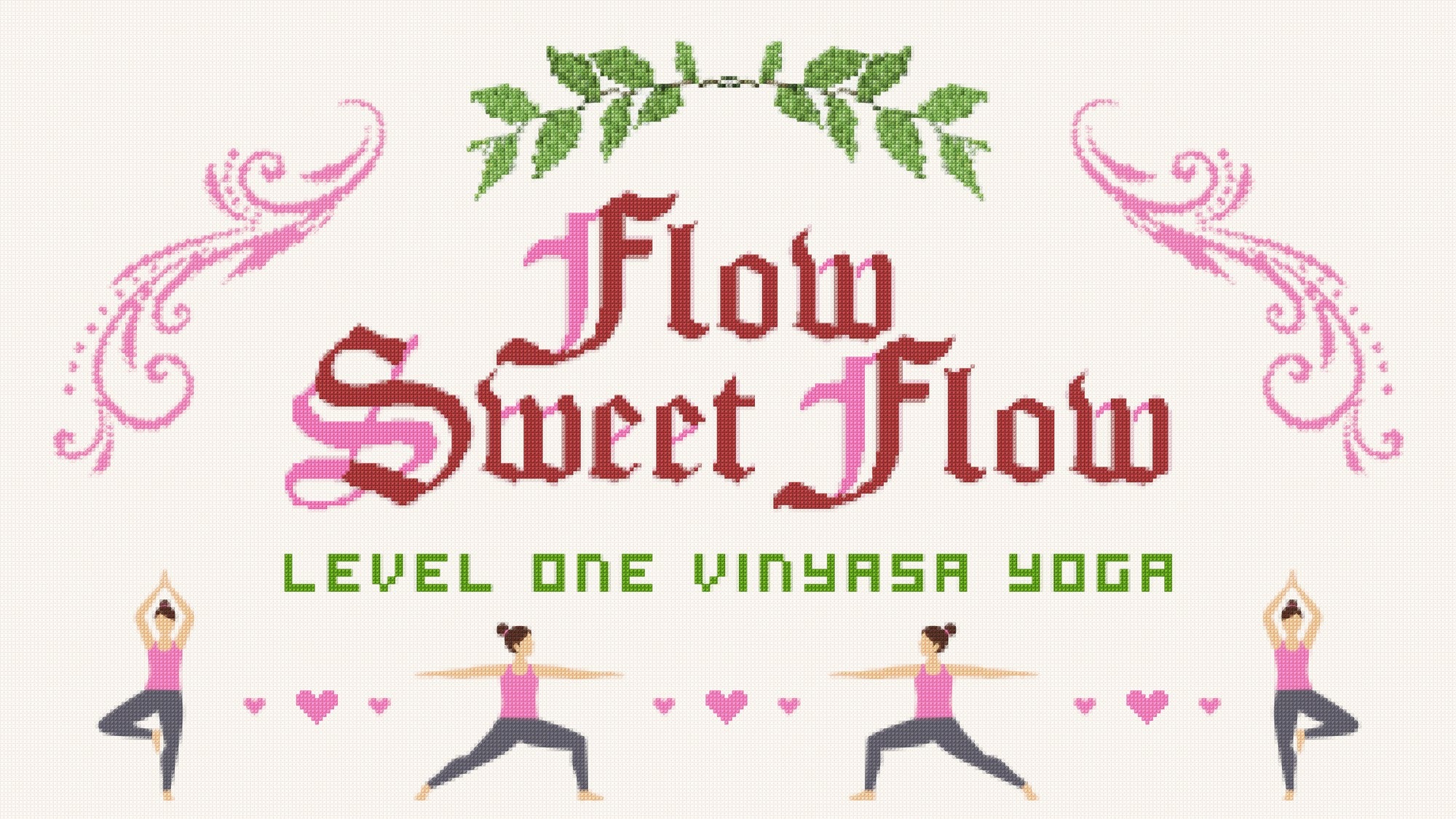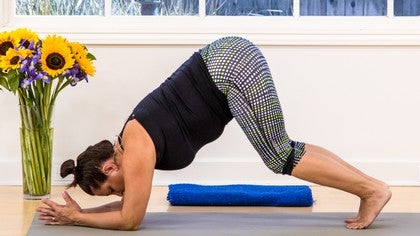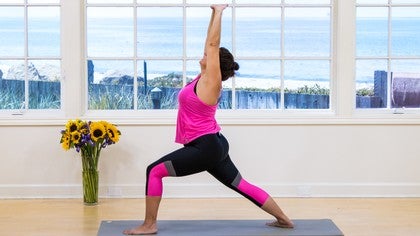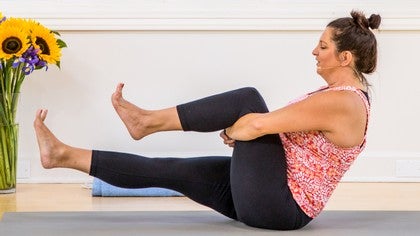Description
Transcript
Read Full Transcript
(Ocean waves crashing) Namaste. Welcome. This is a quick tutorial for you, as you're coming into the vinyÄ쳌sa experience. The first thing I'd like to talk about is transitioning. Transitioning is very interesting in the different classes because teachers do it different ways. Sometimes the teacher's gonna be coming from the ground moving up.
Sometimes the teacher's gonna be coming from up and moving down. So, just being aware of that mentally will help you as you're moving into these different postures and different sequences. It's quite fun and very eclectic as the teachers all come together. You'll end up really enjoying it. The other thing I want to remind you about is being thoughtful as you're moving from posture to posture.
So, one thing we know is that the faster you are, the quicker you are, the quicker we are, the more sloppy we get. And this is a thoughtful practice even though it is a flow practice. So, as you're moving forward and being thoughtful, there's a collection in the body and you're much less likely to be sore and have problem areas in your future with the vinyÄ쳌sa practice. And then, finally, always know that resting is appropriate. So, resting in your child's pose is completely appropriate.
Even if the rest of the class is going on in your mind or the teacher's continuing on, just let yourself rest. You can do that in a nice child's pose, you could even lay on your back and draw your legs into your chest. We call this a upside-down child's pose. It's always appropriate. We want you to take care of yourself and to really enjoy the nature of what you're feeling in the practice.
Now, there's another thing to mention, and we call them modifications. And that's when you're coming into a posture and you're watching the teacher and you're thinking, "There's no way that I'm gonna do that." (laughs) So, here's a few of the modifications: One of the postures that we will do a lot is called downward facing dog. I'm gonna demonstrate this to you. And then I'll show you how to make those changes. So, in downward dog, you'll probably feel it the most in your arms and legs.
But, believe it or not, the posture, the focus is the spine. So, if your legs are really tight at first, you work really hard, and you don't really get the posture in your spine. So, the suggestion is go ahead and bend your legs. And when you bend your legs, you can reach through the arms. And you can allow that spine to get nice and long.
This brings a lot of clarity to the body. I promise that as you practice yoga, your legs will become straighter and straighter and straighter over time. But you do not have to get them straight the first time. Or the 20th time or the 100th time. If you'll let the spine be long, you're gonna let the spine belong.
Right? To you! And you're gonna let the internal organs get all this juice. And you'll feel so much better at the end of the practice. Now, the other thing about downward dog, it's interesting, is sometimes it's complicated in the wrist. Let's say you have a little... an old injury, or your wrists are very tight, and doing that posture, you just feel all the pressure there.
Nice modification for this, it's easy to get into, too, in the middle of the sequence, is simply to drop to your forearms. Palms come together. You go in the posture. Again, if the legs are tight it's gonna shove you forward. So, bend your legs.
And it's quite easy to come into this. It doesn't take that much time. More time than just coming into the dog, and you'll know, "Okay, I'm gonna do it this way." Some days maybe you need it, some days not. We can always rely on that. Using the modifications, how we ask that you do it, is you do listen to your body, because the yoga makes the body feel better.
So, if you're always going on your forearms in downward dog, and you're never trying a dog because you think, "Oh, I just have to do it this way." Mm? Right. So, you're gonna be evolving in your body. Your body's gonna be healing in ways that you may not expect. So, keep exploring it for sure. There's another pose that sometimes causes a little bit of complication.
It's called upward dog. I'll demonstrate it for you. In upward dog, we're lifting the legs off the ground, we're bringing the chest forward. There's a lot of power in the posture, but sometimes, it causes discomfort in the low back at first. Because the belly has to be strong enough to support the back in the posture, 'cause you're sort of hanging.
You don't wanna hang like a hammock. You wanna hang more like a big, strong staff. So, if you find that in your up dog, you simply drop your knees down. And in dropping the knees down, you can engage your abdominals a little more, and then you can bring yourself into the posture in a way that feels good to your back. It's always acceptable to do that.
No matter what teacher you're working with here at Yoga Anytime. So, be aware of that. And you know, sometimes, oh gosh, you gardened the day before, so you've never done it, well then try it! We want these postures and we want this practice to make you feel good. To make your life better. So, this is part of your responsibility to make sure you're finding that for yourself.
Now, I think my favorite and most beneficial thing that I get out of the vinyÄ쳌sa is the plank pose. And the plank pose, looks like this. So, my body's a plank, right? It's not too high. It's not too low.
It's right in the middle. And I'm using my abdominals. I'm drawing in, and up, and I'm powering through my legs. Everything is actually talking to itself. This builds incredible core strength and incredible information between the core body and everything else that's holding you up.
That information highway, along with going to the brain, is super important for building deep strength. Now, when you first start to do it, it's like, "Oh, okay, I do what? I do it like this." And then you're like, (moaning) Right? It's like, "What's happening?" Because the information's not flowing yet. Everything doesn't really know what to do all at once yet. Your body has to learn it. What we suggest is...
Don't be all like willy-nilly in there, right? Go ahead and give yourself a little bit of a break. For me that means what's called a half-plank. The legs drop. The knees drop down. Now, I'm still using my abdominals.
Right? Because if I'm not it looks like this. Still using my abdominals, I like to go ahead and lift the feet. This is more comfortable in the knees. I'm building a lot of strength here.
In fact, some of you may have already experienced doing the push-up that we call Chaturanga Dandasana, right? Now, four-point staff pose. That is really tricky! Because it requires a lot of intelligence, the body working together, the core body strong. And without all those things working, it can be very taxing to the shoulders. So, our suggestion is if you have that in the sequence that you're working with, and you're like, "uh-oh, here it comes." Just pause and stay in this powerful plank.
Because the powerful plank or the powerful half-plank, is gonna build everything you need to one day be able to do those. But you wanna have that strength first. You wanna have that foundation first. The last thing I'll mention is sometimes, also, the wrist can be a little complicated in plank pose. So you'll do the same thing that we did before.
You'll come down to the elbows, palms will be together, and then you'll just straighten the body out in the plank, or you'll drop the knees in the plank. I'm still working! There's still information building and churning and your body's still learning. So, even if it seems like it's less than what was happening, you gotta figure, you might be doing 10 of those things, 20 of those things, in the sequence itself, and in the totality of the class that you're taking. So, err on the side of being intelligent, and being mindful, and feeling the joy of the practice. And this practice, you'll have it for the rest of your life.
You won't ever wanna be without it. So, that's the tutorial. I hope it was helpful. Thank you. Enjoy, enjoy, enjoy Yoga Anytime.
It is a great gift to all of us. Namaste.
Flow Sweet Flow: Laura Tyree
Comments
You need to be a subscriber to post a comment.
Please Log In or Create an Account to start your free trial.


















